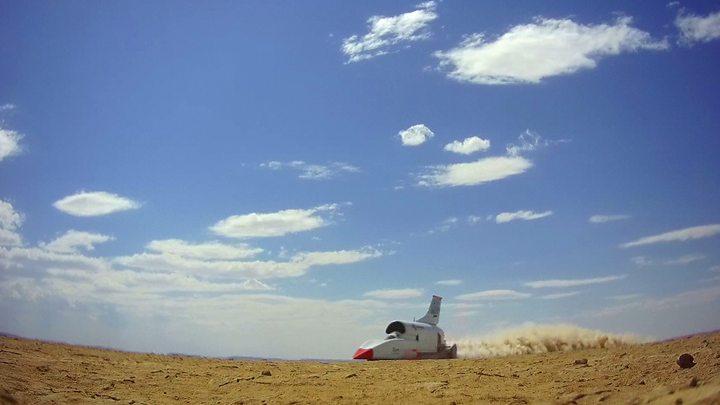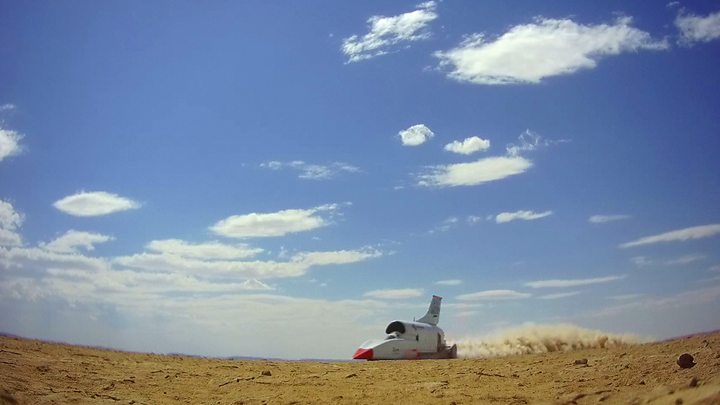Confidence high in Bloodhound land speed record team
The UK-led challenge to the land speed record clocks 501mph in the Kalahari Desert of South Africa. …


Media playback is unsupported on your device
Bloodhound is now a 500mph car. The British-built straight-line racer recorded its highest speed yet during a hot afternoon run across the Kalahari Desert on Wednesday.
GPS instruments in the vehicle clocked 501mph (806km/h).
Bloodhound’s driver, Andy Green, declared himself “chuffed to bits” after bringing the car to a stop.
His team is now increasingly confident it has the means to break the land speed record of 763mph (1,228km/h).
That won’t happen for at least a year. More testing is needed, as is more thrust, which will come from the addition of a rocket motor.
At the moment, Bloodhound is powered by a jet engine from a Eurofighter-Typhoon. The trials here on South Africa’s Hakskeen Pan will determine just how big a boost that rocket must deliver.
“When you see Bloodhound go off the start line, it flies. And that’s with only nine tonnes of thrust from the jet. For the land speed record, we could have another five, six tonnes on top of that from the rocket,” explained chief engineer Mark Chapman.
The car clocked 491mph (790km/h) on Tuesday; and had done 461mph (742km/h) last Friday. It’s been going faster and faster on every outing, enabling the team to explore the handling and stability of the arrow-shaped vehicle.
But while the top speeds are eye-catching, the team is just as concerned to understand how to stop Bloodhound… safely.
It’s no good breaking the land speed record if you can’t then bring the car to a halt inside the length of a track, even one as stretched out as Hakskeen’s at 10 miles (16km).
That’s why a key ambition on Wednesday was to investigate brake chutes.
Bloodhound has two of these, which pop out from the back of the car from two canisters positioned just under the jet’s exhaust nozzle.
They act to slow the vehicle as it comes down through the speed range at 500mph and 400mph.
When a chute was tried a week ago, it jumped around in the airflow behind Bloodhound, making the car twitch out of shape, which Andy Green then had to correct with his steering.
But the chute was subsequently modified to increase its porosity by cutting open some of its panels.
“It came out, bang! Absolutely solid this time,” said Wing Commander Green. “The second chute then came out at a hundred miles an hour slower – I could feel it moving around. But it will be an easy ‘mod’. It takes 10 minutes with a pair of scissors,” he told BBC News.
The team has been presented with various technical niggles along its learning curve.
One tricky problem has been the damage inflicted on the bodywork by the fast stream of air and dust passing over the rear suspension. This forceful flow has been lifting and bending metalwork.
The patch repairs implemented following Tuesday’s run looked untouched after Wednesday’s drive, indicating that engineers probably now have a long-term solution.
But they will be wary of the unexpected. And there was a taste of this right at the end of the latest run.
Andy Green could be heard calling out “fire, fire, fire” over the radio. A sensor system had detected anomalously high temperatures in the jet engine bay.
As the RAF pilot climbed from Bloodhound, rescue vehicles were already on the scene. But no fire was discovered. It’s likely the extreme desert heat – upwards of 37C – had tripped the sensor system.
“It was very hot out there today and maybe on another occasion we wouldn’t have gone out. But we have to take every opportunity that’s given to us,” said Stuart Edmondson, Bloodhound’s head of engineering operations.
Bloodhound’s next outing is likely to be on Friday.
The run could see a speed of 550mph (885km/h) being posted. Certainly, the modelling suggests the current set-up ought to be capable of getting above 600mph (965km/h).
But Mark Chapman says the data streaming from the multiple sensors inside the vehicle is his main priority.
“This car has lived in a virtual environment for the last 10 years or so. Here at Hakskeen Pan, Bloodhound’s behaviour is helping us to validate all the modelling that went into its design.”
The current land speed record of 763mph (1,228km/h) was set in 1997, also by Wing Commander Green.
In doing so, he also became the first person in history to take a wheeled vehicle beyond Mach 1, the speed of sound.
On Hakskeen Pan, at an altitude of 700m (2,300ft), this “barrier” will be around 740mph (1,192km/h).
The speeds posted here by Bloodhound make it the third fastest British car of all time, behind Thrust2, which broke the land speed record in 1983; and Andy Green’s 1997 car, Thrust SSC.
Follow Jonathan on Twitter.


